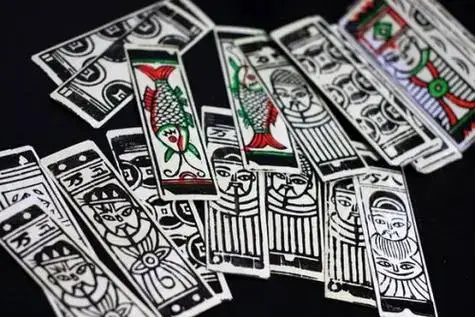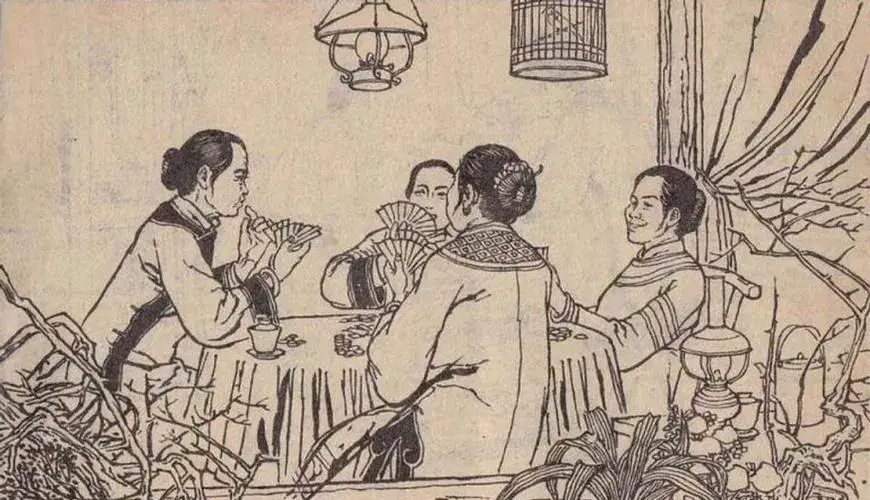Yezixi Play, also known as “Leaf Cards” or “Yezi Ge,” is an ancient Chinese card game that dates back to the Tang Dynasty. After centuries of development, it gradually became a popular form of entertainment.
Yezi Ge is an ancient Chinese card game, similar to “Sheng Guan Tu,” played with dice. Its origin can be traced back to the Han Dynasty and is considered the precursor to modern playing cards, including poker, character cards, and mahjong.
Origin of Yezi Ge:
Theory One:
The origin of playing cards, particularly poker cards, is believed to be in ancient China. Legend has it that during the Chu-Han War, General Han Xin invented Yezi Ge to alleviate homesickness among soldiers. At that time, the cards were the size of tree leaves, hence the name “Yezi Ge.” It is said to be the prototype of modern poker cards.

In the 13th century, Marco Polo is said to have brought this paper card game from China to Europe, sparking great interest among Europeans. Initially a luxury for nobility, it quickly gained popularity among the general population due to its affordability, diverse gameplay, and ease of learning. Westerners innovated on Chinese playing cards, evolving through stages like Winning Cards, Whist, and Bridge, eventually becoming the modern poker cards.
Theory Two:
According to historical records, the invention of Yezi Ge is credited to Zhang Sui, a renowned astronomer of the Tang Dynasty, who created it for Emperor Xuanzong and his concubines as a form of entertainment. The cards were initially the size of leaves, leading to the name “Yezi Ge.” Over time, it spread to the common people and evolved into character cards and mahjong.
How Yezi Ge is Played:
The gameplay of Yezi Ge involves sequentially drawing cards, allowing players to capture lower-ranked cards. It is somewhat similar to Western card games. Before a card is played, it remains face down, and once a leaf card is played, it is revealed. Players then use the visible cards to deduce the remaining cards and strategically compete, much like the play style in poker.
Yezi Ge Rule
Yezi Ge employs a deck of forty cards, divided into four suits – Ten Thousand Strings, Myriad Strings, Bamboo, and Cash. Each suit carries unique significance and functions.

The game typically follows a turn-by-turn card-drawing approach, with players sequentially playing cards. Players have the option to play a higher-ranking card to capture a lower-ranking one. When playing a card, it must be placed face-up, allowing other players to see its value.
In Yezi Ge, each card holds different points and functionalities. Some cards control the game’s progression, others serve for offense or defense, while some contribute to increasing one’s points or decreasing opponents’ points. Hence, players need to strategically choose cards based on their tactics and opponents’ situations.
Apart from playing cards, players also need to deduce the unrevealed cards based on their own hand and the cards already played by other players. This requires players to possess high-level thinking and reasoning abilities.
Yezi Ge encompasses various gameplay styles, including Landlord, Mahjong, and more. Each variant comes with distinct rules and victory conditions. In Landlord, the first player to play all their cards wins, while in Mahjong, the player with the most points at the end emerges victorious.
Yezi Ge can also be played in a gambling context. In some regions, Yezi Ge has become one of the primary forms of gambling. However, gambling is illegal, causing harm to individuals and society, and violating the law. Therefore, it is advisable for everyone to refrain from engaging in any form of gambling activities.
In summary, Yezi Ge is a card game that is easy to understand yet demands strategic skills. Playing Yezi Ge allows people to relax, pass the time, and enhance their cognitive and decision-making abilities. Additionally, Yezi Ge serves as a means of cultural inheritance and exchange, providing insights into traditional Chinese culture and history.
Evolution of Yezi Ge:
Yezi Ge appeared in China during the Han Dynasty, as recorded in the mid-Tang period. Su E’s “Biography of Princess Tongchang” provides a detailed description of Yezi Ge during the Tang Dynasty. Yezi Ge had matured considerably during this period, indicating its widespread popularity among the general population.
In the Song Dynasty, Queen Zhou, the consort of Li Houzhu, further developed Yezi Ge into a new game called “Golden Leaf Grid.” The game continued to evolve in the Yuan Dynasty, where Yang Danian made additional improvements, renaming it “Crane Grid,” which persisted into the Ming Dynasty.
During the Ming Dynasty, the game’s style and rules became well-established, reaching the point where it was eventually believed to have evolved into horse-hanging (Ma Diao) cards, red mansion Yezi Ge, and poetry cards during the Qing Dynasty.
By the Qing Dynasty, the styles and rules had essentially been perfected, leading to the gradual transformation into horse-hanging cards. Therefore, in Dr. Joseph Needham’s “Science and Civilization in China,” the invention of bridge is attributed to the Chinese.
Yezi Ge spread to the West during the Yuan Dynasty and transformed into tarot cards and modern poker, while in China, it gradually became mahjong and Pai Gow.
Influence of Yezi Ge Development:
Around the 13th century, Yezi Ge made its way to Europe. After centuries of evolution, blending with various card games from different cultures, it gradually formed the internationally recognized pattern of playing cards—poker.
Early playing cards in different countries had different numbers of cards, such as Italy with 22 cards, Germany with 32 cards, and Spain with 40 cards. The commonly seen 54-card deck, including the addition of jokers, originated from the 52-card deck introduced in France in 1392, with the innovation of big and small jokers. It is noteworthy that China is considered the homeland of playing cards.

In China, Yezi Ge used astronomical calendars as a reference, dividing the cards into four categories: “Yi” (bamboo), “Xiang” (characters), “Si” (silk), and “Shi” (seasons), which corresponds to the four suits in poker. Yezi Ge likely reached Europe in the 13th century and, through centuries of evolution, combined various card games from different cultures to gradually form the internationally recognized pattern of playing cards—poker.
Records of Yezi Ge date back to the Tang Dynasty, as mentioned in Su E’s “Biography of Princess Tongchang.” By the Five Dynasties period, numerous books describing card games had emerged, such as “Pian Jin Zi Ge” and “Xiao Ye Zi Ge.” During the Ming Dynasty, Yezi Ge became extremely popular among literati, as noted by Wang Chongjian in “Winter Night Annotations”: “Scholars are obsessed with it, spending day and night playing like fools or madmen.” Feng Menglong also wrote “Ma Diao Pai Jing” during this time. In the late Ming Dynasty, Yezi Ge gained immense popularity among the common people, and by the Chongzhen period, it had become a widespread pastime.
In conclusion, Yezi Ge’s influence on the development of card games is significant, particularly as it is considered the precursor to modern playing cards, including poker, which has become a globally popular and enduring form of entertainment.
Reference:
“Talking About Leaf Play.” China News Network. 2010-05-05. [Accessed on 2013-06-21].